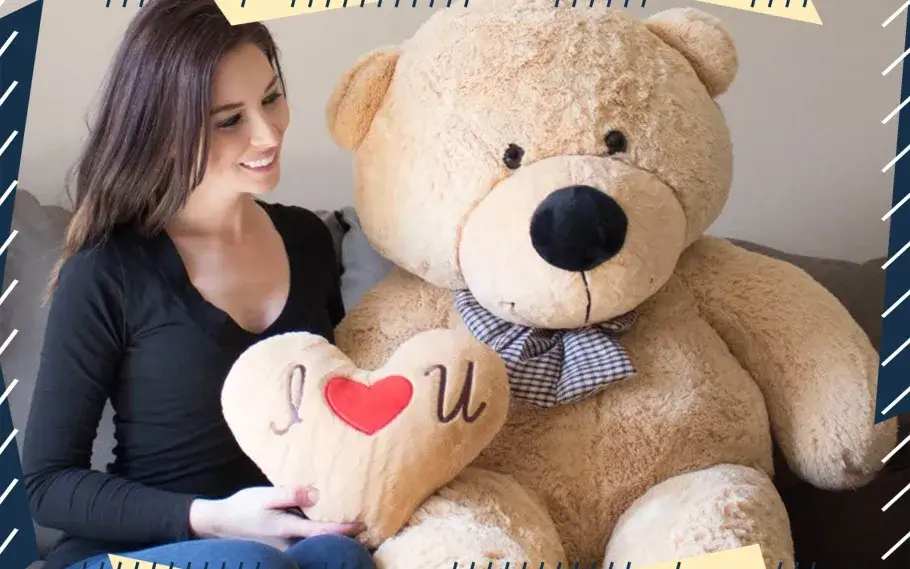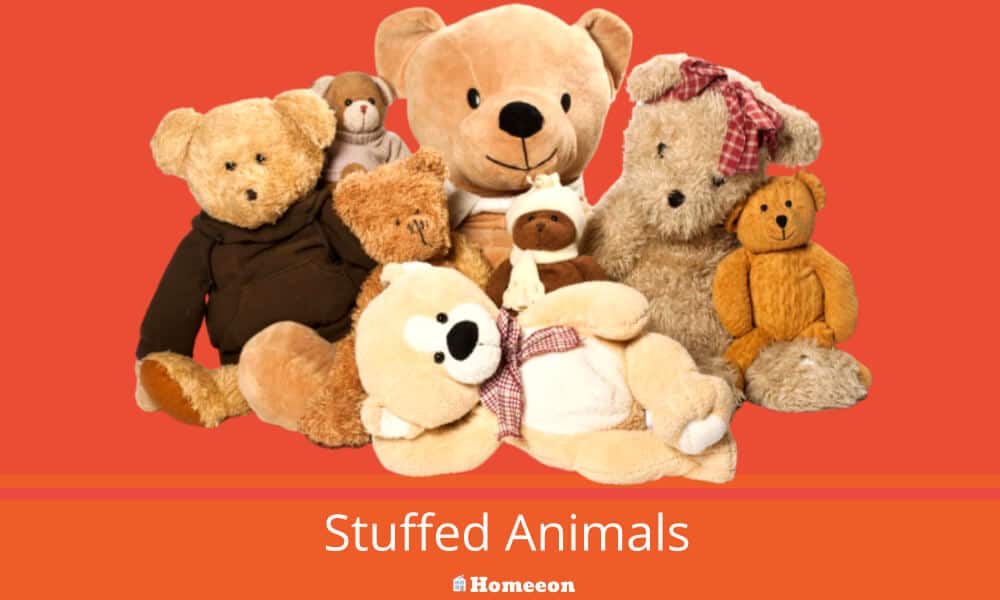Last Updated on August 14, 2023 By Emma W. Thomas
Stuffed animals are typically made of soft materials like polyester, cotton, or acrylic. The outer fabric is often plush or velvety, while the filling consists of polyester fibers or foam. These materials ensure cuddly textures and shapes for comforting and playful experiences.
What Are Stuffed Animals Made Of

1. Main Material – Fabric and Plush
The outer layer of stuffed animals is typically made from a variety of fabrics. This includes cotton, chenille, fleece, or velvet. However, the most common fabric used is plush due to its soft texture, making it perfect for cuddly stuffed animals.
2. The Stuffing – Polyester Fiberfill
Stuffed animals get their name from the stuffing used to fill them. The most common type of stuffing used is polyester fiberfill. This material is lightweight, durable, and hypoallergenic. It is chosen for its ability to retain shape even after many rounds of rough play and washing.
3. Weighted Material – Poly Pellets or Glass Beads
To give some weight to a stuffed animal, some manufacturers use weighted materials such as poly pellets or glass beads. These materials add a realistic feel to the stuffed animals, making them feel more “alive.”
| Weighted Materials | Reasons for Use |
|---|---|
| Poly pellets | Lighter weight, non-allergenic, economical |
| Glass beads | Heavier weight, smoother feel |
4. Eyes and Nose – Plastic, Glass or Safety Eyes
The eyes and noses of stuffed animals are made using dyes or sewn in using yarn or thread. For higher-quality stuffed animals, safety eyes and noses made of plastic or glass are commonly used. These are securely fixed to the fabric and are difficult to remove, adding to the overall safety of the toy.
5. Embellishments – Yarns and Threads
Details on stuffed animals, such as whiskers, spots, or stripes are often added using yarns or threads. These enhancements can be a wide range of materials from silk threads for a shiny effect, wool for a more rustic look, or embroidery floss for detailed work.
6. Coloring – Dyes and Paints
The vibrant colors and patterns seen on many stuffed animals are usually achieved through the use of dyes and paints. These substances are applied to the outer fabric before the animal is assembled. The inks used are typically non-toxic and safe for children.
7. Sound Modules – Plastic Box with Electronics
Sound-making stuffed animals include a small sound module inside them. This is essentially a plastic box that holds the electronic components needed to produce sounds when activated. This feature enhances the interactive aspect of these toys.
History
A pair of homemade sock monkeys, part of US and Canadian culture
The first commercial concern to create stuffed toys was the German Steiff company in 1880. Steiff used newly developed technology for manufacturing upholstery to make their stuffed toys. In 1892, the Ithaca Kitty became one of the first mass-produced stuffed animal toys in the United States.
Stuffed Toy Animals For Sale
In 1903 Richard Steiff designed a soft stuffed bear that differed from earlier traditional rag dolls because it was made of plush furlike fabric. At the same time in the US, Morris Michtom created the first teddy bear after being inspired by a drawing of President “Teddy” Roosevelt with a bear cub. In 1903, the character Peter Rabbit by English author Beatrix Potter was the first stuffed toy to be patented.
Types
“Teddies shop” in Lima, Peru
Handcrafted
Amigurumi is a Japanese type of handcrafted knitted or crocheted stuffed toy. Amigurumi are typically made to look cute with oversized heads and undersized extremities.
Sock monkeys are a type of handmade stuffed monkey made out of socks, which first appeared in the US during the Great Depression.
plush flower
Brands
Brands of stuffed toys include Pillow Pets, whose toys can be folded from a pillow into a stuffed animal; Tickle Me Elmo, a laughing and shaking plush toy based on the character Elmo from the Sesame Street television show, released in 1996; Furby, a robotic talking plush toy with its own language, released in 1998; and Zhu Zhu Pets, a line of robotic plush hamsters released in 2009.
Some brands of stuffed toys used marketing strategies to encourage the collection of a series of stuffed toys. One of the most notable stuffed toy collections includes Beanie Babies.
Virtual Brands
Webkinz stuffed animals were created by Ganz in 2005. Each Webkinz toy comes with a unique “Secret Code” that gives access to the Webkinz World website and a virtual version of the toy for online play. Disney’s Club Penguin and Build-A-Bearville from Build-A-Bear Workshop were formerly other online worlds with content that could be unlocked from codes found on associated stuffed toys. In 2013, Disney launched its first collection of Disney Tsum Tsum stuffed toys based on characters from different Disney properties, inspired by the popular app of the same name.
Impact
Stuffed toys are among the most played-with toys of children. Their size and softness make them ideal for toddlers since it is almost impossible for them to be injured by one. However, they are not exclusively for toddlers and are often played with by children right up into their pre-teens. Their resemblance to characters or animals allows for imaginative free play, especially with other children, and there is no real limit on the amount of time one can spend playing with them. Stuffed toys do sometimes tear, but with a sewing needle and rudimentary sewing skills, the damage is often easily repairable. Their low price, combined with their demand, means that it is common for children to possess tens of stuffed toys at a single time. Some households report having stuffed toys numbering in the hundreds.
Is it possible to machine-wash stuffed animals?
Yes, many stuffed animals can be safely machine-washed, but there are important considerations to follow:
- Check the Label: Look for care labels on the stuffed animal. If it indicates “machine washable,” you’re likely good to go. If there are any specific instructions, follow them.
- Preparation: Close any zippers, buttons, or fasteners, and place delicate items like plush toys inside a pillowcase or laundry bag. This prevents them from getting tangled or damaged in the wash.
- Gentle Cycle: Use a gentle or delicate cycle on your washing machine. This reduces the agitation and friction that could harm the stuffed animal’s fabric or stuffing.
- Mild Detergent: Use a mild laundry detergent that is suitable for delicate fabrics. Avoid using harsh chemicals or bleach, as they can damage the fabric and colors.
- Cold Water: Use cold water to prevent colors from bleeding and protect the fabric. Hot water can cause shrinking and fading.
- Spin Speed: Opt for a low spin speed to minimize stress on the stuffed animal’s seams and stitching.
- Rinse Thoroughly: Make sure the stuffed animal is thoroughly rinsed to remove all detergent residue.
- Drying: Air-dry the stuffed animal whenever possible. Avoid using direct sunlight or high heat, as they can fade colors and damage the fabric. You can reshape the toy during the drying process to maintain its original shape.
- Fluffing: After drying, gently fluff the stuffed animal to restore its softness and shape.
- Stain Removal: If your stuffed animal has stains, consider spot cleaning before washing the entire toy. Use a damp cloth with mild detergent and gently blot the stain.
References:
https://fluffystuffie.com/blogs/learning-and-development/what-are-stuffed-animals-made-of
https://www.thebitesizedbackpacker.com/stuffed-animals/stuffed-animals-a-complete-guide/
Emma is a graduate of Domestic Science or Family and Consumer Sciences (Home Economics) from the University of Wisconsin. She has 7 years of experience Working with the strategic section of BestBuy and now writing full-time for Homeeon.
From Managing the Home, Interiors, Cleaning, and Exteriors to Gardening and everything about Making A Home Liveable – is her passion and this Homeeon is the result of this.
Emma loves decorating her home with the best stuff found online. She cares about quality over anything and writes reviews about them here in Homeeon. Get in touch with her over Pinterest.
Keep reading her blogs.

